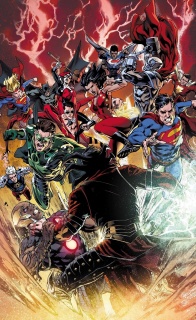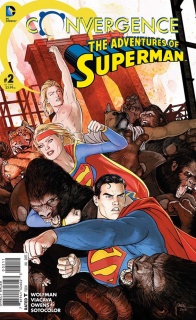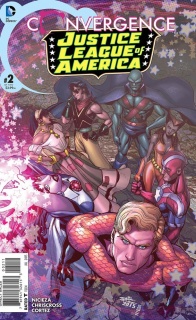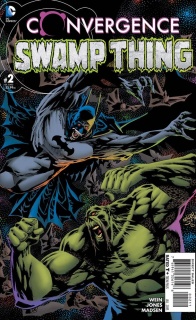We at the DC3 have been through a lot together – we’ve seen villains take over our beloved books, we read a month’s worth of “Five Years Later” stories, and we’ve tackled a year of weekly titles, and we’ve come through it all stronger. But here we are, at our most challenging time as a unit: “Convergence.” Calling ourselves the DC3 just wouldn’t cut it anymore. We needed a new name, one that transforms us from boys into men, from civilians into soldiers, from sidekicks into superheroes. For the next two months, the DC3 are no more: long live the Convergents!


Convergence #7
Written by Jeff King & Scott Lobdell
Illustrated by Aaron Lopresti
Reviewed by Vince J Ostrowski
While the “Convergence” tie-ins have been pleasantly surprising in their quality (for the most part, and taking into consideration what we normally get from a major crossover event), the main series has been rife with inconsistencies both technical and in its ability to effectively tell its story. Rifts in time and space are an exceedingly common plot device in comics, but unfortunately they are not a terribly compelling device for telling a story through conflict. Consider the events of issue #7: The Earth Prime Justice League characters currently observe the rift from outside of the world of Telos, meanwhile, the heroes and villains of the vast DC multiverse do battle on Telos. The kidnapped members of the multiverse remain at one another’s throats, while the sentient Telos and Deimos face off against one another. Captain Marvel pummels Pre-Flashpoint Superman as he revels in how much fun this all is. But it’s not all that fun, is it, when it seems more logical that the trapped victims of Telos could all turn against Deimos and overpower him instead? What are the motivations for the villains to do what they’re doing? One can only take so many double page spreads of Multiversal heroes teeing off against other versions of themselves before it all comes off as nonsense, accomplishing nothing. The “Convergence” tie-ins have, at their best, been about intimate moments between all sorts of myriad characters throughout DC’s history – whether in combat or in friendship. On the other hand, the main series is about multiple versions of DC characters getting each other in headlocks and yelling about how they’re not even sure what or why they’re fighting. No one speaks in a complete thought in “Convergence.” “Who are you?” “What the hell now?” “What do we do now?” The Convergence event rolls through amorphous turning point after turning point without the reader or the characters being able to absorb them. Things happen and no one in the comic understands them. They just fight. Comics like this are all too frequent and much of the reason why event comics feel so disappointing and shallow.
Those double-page spreads look great – no doubt. In spite of some technical issues, Aaron Lopresti does a great job with the character renderings. The sheer number of DC characters depicted inspire feelings and memories based on the different versions of the seen among them. But even as a visual experience, “Convergence” is a one-trick-pony that is wearing out its welcome. The aforementioned technical issues include a Guy Gardner that has lost his facial hair and gone from a Red Lantern to his original Green Lantern costume between issues and spacial weirdness that causes images like the one included below There’s no reference or explanation as to why we’re seeing these multiple versions of the characters outside of Telos. It, and several other moments, play out as random images on a page. I’m sure there’s an explanation for it, but it doesn’t come across in a story segment that I had to read several times to convince myself I wasn’t missing something. While the art looks good enough for a DC event title on its own, there’s a greater problem inherent in slapping together a crossover event with a different artist tackling each issue – details slip through the cracks, and no one depicts things consistently. We know this is a “band-aid” event to get DC through a cross-country move, but they’re charging the same amount of money for it. A higher quality product is not too much to ask for.
Continued belowFinal Verdict: 3.0 – “Convergence” is an event full of worthy tie-ins, but with a main series that is entirely too comfortable with being total nonsense.

Convergence: Adventures of Superman #2
Written by Marv Wolfman
Illustrated by Roberto Viacava
Reviewed by Brian Salvatore
Last month, this issue felt completely out of place, in both good and bad ways, from the event surrounding it. This month, it adds Kamandi into the event, which is never a bad thing, and gets a little more in line with what the event is ‘supposed’ to feel like.
And then, of course, Wolfman has to give Supergirl a psychic vision of her death or something.
Look, I get it – you want to separate yourself from the pack with these tie-ins, and do something different. As someone who is growing quite tired of reading these, I get that. But change for change’s sake is rarely good. Especially as this whole issue has Supergirl having a premonition of her own death, and she keeps brushing it off, even after her own death is prevented! If you’re going to introduce her ‘destined’ death, then she needs to at least talk to Clark about it, but nope! It is just a weird through line that never gets discussed.
Luckily, Viacava continued his great work, nailing the tone of the time period, and adding Kamandi into the era seamlessly. His work is really quite impressive, especially his handling of the Super-cousins, which feels both “Crisis”-appropriate without just trying to ape the work of others.
Final Verdict: 5.2 – Visually, one of the best issues of the week, but really disappointing from a story perspective.

Convergence: Batman and the Outsiders #2
Written by Marc Andreyko
Illustrated by Carlos D’Anda
Reviewed by Zach Wilkerson
Last month I docked “Batman and the Outsiders” for its era inaccurate art. Since there’s no use in beating a dead horse, I’m overlooking this point for the second issue. D’Anda’s art is tightly crafted, a real visual feast. It’s hard to knock the creator for doing such terrific work.
Plot-wise, the issue still has a few faults. The conflict between Godmother/OMAC and the Outsiders never feels compelling, as hero and heroine alike throw themselves against the mechanical hulk. The battle ends quickly, followed by an equally rushed denouement and the typical non-ending seen in many “Convergence” tie-ins. Most of the character development and conflict presented in the first issue is forsaken in lieu of fisticuffs. The exception to this is Metamorpho’s return to a life without his beloved Sapphire, but even this plot-point is quickly glossed over and left unresolved. Even with a fun cast and some truly noteworthy artwork, it’s hard to recommend this title as a “must read.”
Final Verdict: 6.0 – Lots of style, little substance.

Convergence: The Flash #2
Written by Dan Abnett
Illustrated by Federico Dallocchio
Reviewed by Vince J Ostrowski
Dan Abnett pits Barry Allen against the Tangent Universe Superman in a battle of wits over anything else. In an event that has been predicated on cross-multiversal beatdowns, it was fascinating to watch a speedster go up against a cerebral superman, favoring brain power over braun. “Convergence: The Flash” ends up being one of the best stories in the entire event by quite literally analyzing the idea of divergent worlds battling one another in the first place. It’s the ultimate change of pace in an event that sorely needed one. Longtime DC fans will appreciate the way that Barry Allen’s importance in a “crisis” takes center stage. Abnett crafts his story into an unexpected emotional journey by the end. It also includes some of the best art of all the tie-ins, with Dallocchio’s wide, cinematic approach contrasting well with the quiet, cerebral feel. Before long, Dallocchio will get the call when it comes time to do a main event book down the road – his detailed and honed style gives every moment more gravity.
Final Verdict: 9.0 – One of the finest “Convergence” titles – a patient, emotional journey over 2 issues.
Continued below
Convergence: Green Lantern Corps #2
Written by David Gallaher
Illustrated by Steve Ellis
Reviewed by Brian Salvatore
This was my favorite tie-in of last month’s “Crisis” era books, and the second issue doesn’t disappoint, either. This issue is one of the few that deals with the sheer weirdness of the situation at hand; sure, these folks are all heroes, but they should still be taken aback by the events of the series, and too many times, they treat it like it is a minor inconvenience at best. “Green Lantern Corps” doesn’t do that.
Steve Ellis’s art is truly a joy to behold, but I do have one small nit-picky thing: if you’re not going to put Guy in his classic, vested GLC uniform, then you’ve got to make his hair look super bright red and in more of the bowl cut variety – there were action moments where it was hard to tell if I was looking at Hal or Guy, and that is something that can usually be pretty easily determined.
Aside from that one small area, though, this issue is one of the best in the entire event. Guy is represented in a pitch-perfect way, never losing his heroism but also not necessarily playing by the rule book, either. His interaction with Hercules (yes, you read that right) and his attitude towards his fellow Lanterns establish him, in just two issues, as one of the more complex heroes of this entire event.
Final Verdict: 8.9 – A really fun jaunt with the ‘classic’ Earth-based GLs

Convergence: Hawkman #2
Written by Jeff Parker
Illustrated by Tim Truman
Reviewed by Vince J Ostrowski
“Convergence” tie-ins have ranged from poor, to merely fun diversions, to absolutely captivating two-parters, but surprisingly few have inspired in me a desire to see a proper series spun out utilizing the characters or style of a particular title. Going into the event, I expected to want a bunch of different titles featuring some of these underutilized or forgotten characters and eras, but it didn’t end up working that way. “Convergence: Hawkman” is one of those very notable exceptions. First of all, Tim Truman is an artist that could take a DC series today and draw the hell out of it. I’d buy it just for having his name on it. Here, Truman depicts the Hawkman characters in a classic sense, inspiring memories of the characters that – no joke – some people once knew and loved. His style is timeless, and his skill in depicting a swashbuckling type of comic book is considerable. And that’s what he and writer Jeff Parker intended on giving us with this one: A “Hawkman” title that finally gets away from the clutter and swashbuckles its way back into our hearts. Within the pages of issue #2, Katar and Shayera take themselves to the edge of defeat against the Manhawks and then come back swinging – it’s almost a metaphor for the struggling property itself. But “Convergence: Hawkman” stands out in a crowd, and is the type of book that deserves to keep its spirit going.
Final Verdict: 9.0 – “Convergence: Hawkman” is a tone-perfect take on these characters – equal parts swashbuckling adventure and heart-tugging romance.

Convergence: Justice League of America #2
Written by Fabian Nicieza
Illustrated by ChrisCross
Reviewed by Brian Salvatore
It is fitting that Aquaman is a part of this Justice League team, because this issue reminded me of the New 52 “Aquaman” books for a few reasons: because it spends half the issue trashing the heroes, because it goes unnecessarily dark and gritty, and because with just a few tweaks here and there, it could have been so much better. This issue continues the idea of this Justice League being the lamest Justice League ever, which helps nothing out, either in story or in sale, and just gives the team yet another challenge to overcome – which they don’t really do, as even members of their own team bash the team!
Continued belowChrisCross is just the wrong artist for this book – his work sticks out as being incredibly inappropriate for the era for which he has been tasked with illustrating, and he brings too much gravitas to a team that could’ve – and should’ve – been celebrated for the fun and diverse lineup. His work appears stiff and overwrought, and nowhere in the issue is this more clear than the moment that the ‘big 3’ of Zatanna, Martian Manhunter, and Aquaman show up and save the day in one panel, where they really do nothing, physically, but are depicted as if they are solving the most complex equation of all time.
Final Verdict: 3.2 – A team that deserves a revisit gets one of the lamest tie-ins

Convergence: New Teen Titans #2
Written by Marv Wolfman
Illustrated by Nicola Scott
Reviewed by Brian Salvatore
Before I spend most of my time complaining about this issue, let me say this: Nicola Scott clearly has been reading “Grayson,” and so she spends extra time and attention making sure that Dick’s butt looks great. Well played, Nicola.
I don’t understand how Marv Wolfman, the writer who handled this exact era and these exact characters, can reduce them all to stereotypes so quickly and so thoroughly. Starfire is a deathbot, Jericho is Monet, and Gar is even more obnoxious than usual. This issue actually tones down the brash characterizations a little bit from last month, and it is still exhausting to get through.
Scott does fine work here, but is called upon to do too much of the heavy lifting. This script is bare bones and cliched, and doesn’t do anything to enhance the legacy of DC’s, perhaps, most beloved run of all time.
Final Verdict: 5.8 – A true missed opportunity.

Convergence: Superboy and the Legion of Super Heroes #2
Written by Stuart Moore
Illustrated by Peter Gross
Reviewed by Zach Wilkerson
After a strong debut filled with interesting potential, Moore drops the ball in this conclusion. The conflict between the Legion and the Atomic Knights is particularly one-dimensional. The motivation for the Atomic Knight’s attack, that these heroes did not save them, is particularly peculiar considering they aren’t even their heroes. An oddly dark flashback to Clark’s childhood in Smallville that bookends the issue contributes little to the issue’s theme, but rather adds unnecessary unease thanks to a strangely morbid Jonathan Kent.
Taking the place of last issue’s Gus Storms is Peter Gross. Gross’ style is less stylized than Storms and the returning John Rauch’s colors are considerably more subdued this time around. The result is an issue that feels more polished than the last, but at the price of slighter stiffer, less dynamic comic.
The idea of a descendant of Brainiac existing in this city, a prospect I was particular excited about, is neither expanded upon nor even acknowledged. It’s a shame; as such a plot thread could have lent extremely interesting story implications to a series that otherwise lacks drive. The relationship between Superboy and Lightning Lass is touching, pulling at the painful nostalgia of lost love and coming age. Moore’s take on the Legion is something I’d love to see more of, without the limitations of “Convergence”
Final Verdict: 6.8 – The Atomic Knights drop a bomb on an otherwise interesting Legion tale.

Convergence: Swamp Thing #2
Written by Len Wein
Illustrated by Kelley Jones
Reviewed by Zach Wilkerson
While last issue saw “Swamp Thing” creator Len Wein take the reins of the character once again, this issue finds artist Kelley Jones return to the vampiric Batman of “Batman: Red Rain.” The blending of these two properties, along with the creators who spawned them, is perhaps one of the most successful pairings in all of “Convergence.” That the story bucks convention, telling a tale of monsters banding together to fight even worse monsters, makes this title even more special amidst the sea of “Convergence” tie-ins.
Wein’s use of narrative caption boxes invokes the feeling of 80’s horror comics, while Jones’ pencils are equally evocative of that special era. The story, while fairly straightforward, makes great use of these characters and the worlds they inhabit. Wein and Jones even manage to give one character a strong heroic sendoff, deliver a great emotional payoff in just one issue.
Continued belowFinal Verdict: 8.3 – With a perfect blend of creators, characters, and style, “Convergence: Swamp Thing” is a prime example of what a “Convergence” tie-in should strive for.

Convergence: Wonder Woman #2
Written by Larry Hama
Illustrated by Aaron Lopresti
Reviewed by Vince J Ostrowski
I think the key to getting “Convergence: Wonder Woman” right, despite it falling victim to some of the same traps that weaker tie-ins have, is that the take on the central character is so strong. Larry Hama knows what makes Wonder Woman a great character, and always keeps her character at the forefront, even while she’s going toe-to-toe with characters she has no business being in the same comic with. When we last left Diana, she was attempting to rescue Etta from a religious cult that also happened to help shuttle in the vampiric Red Rain villains (The Joker, Catwoman, Poison Ivy). The entirety of issue #2 plays out this conflict, with Diana feeling more and more desperate and compromised as the pages turn. Her relationships with Etta and Steve Trevor are on the line, as well as this version of Gotham City that she’s been tasked with defending. “Convergence: Wonder Woman” uses more effective storytelling and emotion to succeed in putting a final end to some of these characters, while other books that attempted the same sort of finality failed at doing the same thing. It’s not perfect, nor an ideal situation for these characters in the least, but it feels like Hama spends the requisite amount of time establishing Diana’s emotional rollercoaster, where a lot of other writers simply did not.
Aaron Lopresti’s art is not as polished as it is on “Convergence” #7 (also out this week), but it is perhaps more fitting for the story at hand. He draws the vampiric Joker with wild, flailing hair and a frightening rictus grin beyond what we usually see from the character. Lopresti clearly had a lot of fun rendering the different Gotham City villains in their horror-inspired states and his ability to portray the action with clarity and fluidity is a far superior example when compared to his “Convergence” issue, as well. The mark of a strong writer-artist collaboration.
Final Verdict: 7.0 – A solid “Convergence” entry built on a strong sense of the title character mixed with an artful depiction of the “Red Rain” characters.
Vince’s Thoughts:
While I can no longer tolerate the main “Convergence” title for its ultimately rudderless meandering, week 3 was a great success when it came to tie-in stories that contained a greater emotional tether than most. The creative teams were generally strong this week, and they turned out product that, while very much part of a greater event, felt like it came from a place of admiration for the characters. Week 2 felt entirely cynical to me. Week 3 (and presumably Week 4) shows a great affection for decades of DC history.
Zach’s Thoughts:
My biggest fear for “Convergence” is that it would be “The Multiversity”-lite. In truth, it’s actually more “Crisis on Infinite Earths”-lite. My second biggest fear was that the likes of Jeff King, Scott Lobdell, and a rotating team of mostly lesser-known artists wouldn’t be able to anchor and tent pole comic event. While I think the team has done a fairly solid job of assuaging that fear, “Convergence” #7 shows some unacceptable chinks in the armor.
There have been a number of minor continuity and production errors throughout the series that have been fairly easy to overlook, but issue #7 is extremely problematic in this regard. After seeing Guy Gardner as a bearded Red Lantern in previous issues, this issue sees him revert to his classic Green Lantern look. In a massive spread page of characters duking it out, we see a number of characters that have supposedly already bit the dust, such as Superwoman of Earth-3, alive and kicking. You may say my critiques seem petty and nitpicky, as you imagine me pushing my thick framed glasses further up the bridge of my nose and breathe in deeply through my mouth (I don’t wear glasses and breath just fine through my nose, than you very much). To me, these problems demonstrate a lack of care and communication between the editors and the creators. I realize that DC is going through a massive change right now, and some things are bound to fall through the cracks. However, this is a book that (supposedly) sold around 100,000 copies per issue last month. To put that many copies of a half-baked product into the hands of readers just isn’t good business.
Continued below/Rant over. To be honest, I’m still enjoying “Convergence” far more than I ever imagined I would (sorry, Vince!). Small things, like seeing Parallax take center stage, set my fanboy heart ablaze. It’s extremely far from high literature and it doesn’t come anywhere near my favorite DC stories. Still, with only one issue to go, I’m extremely excited to see how the series wraps and dare to hope that the series will have lasting consequences for the DC universe.
Brian’s Thoughts: I don’t know if this is just fatigue, or what, but even though this was a strong week last month, I am really not feeling a lot of this right now. My enjoyment of these books, even the really good ones, were hampered by the fact that, at this point, everything is pointless – we see that the worlds are all going back to normal, and the ‘battles’ are rarely that at all. Sometimes, like in “The Flash,” that’s fun. Other times, when the entities do fight, the outcome is incredibly predictable.
And, again, the lack of era-specific artwork is really hurting the product. A few of these books offer no visual evidence of a past time period, and that is just ridiculous. While the main series disappoints for large reasons, the tie-ins all seem like, with just minor editorial oversight, they could’ve really been something special.






